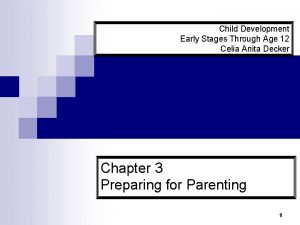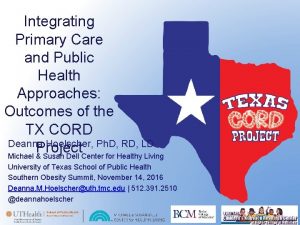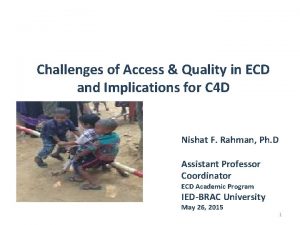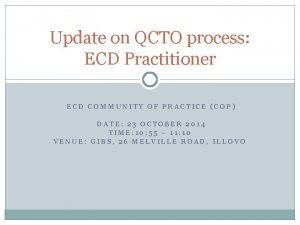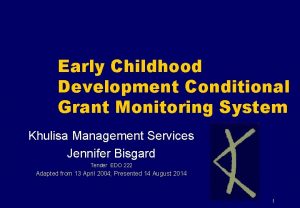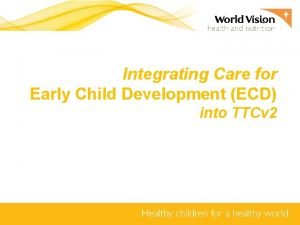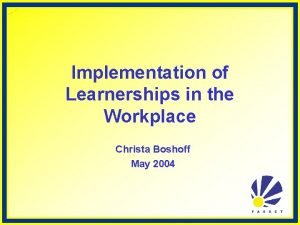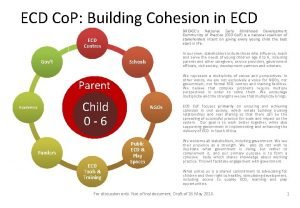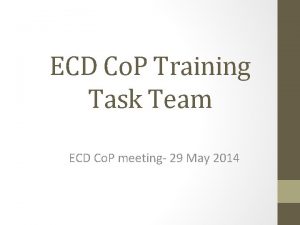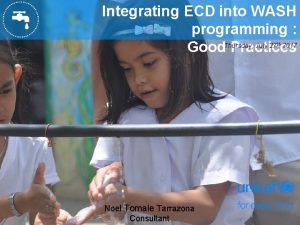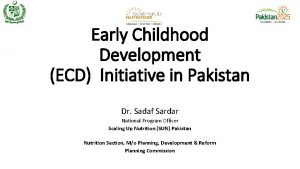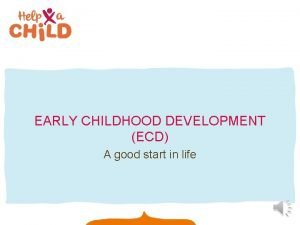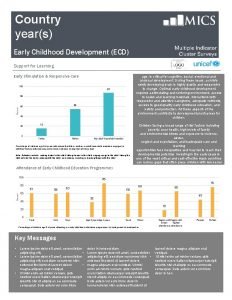Integrating Care for Early Child Development ECD into













- Slides: 13

Integrating Care for Early Child Development (ECD) into TTCv 2

ECD Training: Agenda • Rationale for ECD inclusion into tt. C curriculum • Orientation to Module 3, Session 4 ü ü ü Interactions with Caregivers Communication and Play at Ages and Stages (0 -2) Role of Father Brain Development Activity Counselling the Family on ECD Barriers and Enablers for ECD • Summarizing what we have learned

ECD : Learning Objectives ü Understand explain why communication and play with young children (ages 0 -2: newborns, infants and toddlers) is as important to child development as good health and nutrition. ü Explain how to counsel the family (mother, father, and any other primary adult caregivers) on age-appropriate play and communication activities ü Describe how the family’s practices, behaviours and psychosocial dynamics in the home can influence early child development. ü Identify potential areas for improvement in caregiver- child interactions (counsel) and/or developmental concerns (refer).

ECD for tt. C: Evidence Base • Lancet (2005, 2007 & 2011); Pediatrics Journal (2012); Harvard Center for Developing Child; New York Academy of Sciences; World Bank; World Health Organization; UNICEF • 200 million children < 5 fail to reach full developmental potential due to poverty, poor health and nutrition, and inadequate care • Adverse experiences in the first 1, 000 days of life lead to reduced: physiological response (immune & nutritional uptake), cognitive, language, and social emotional attainment…. resulting in lower adult functioning. • Positive, supportive, responsive caregiving experiences in the first 1, 000 days of life serve as protective, preventative, promotive factors for healthy lifelong

ECD: Why do we need to integrate into tt. C? • Babies and toddlers SURVIVING AND THRIVING “It is easier to build strong children than to repair broken men. ” - Frederick Douglass • Positive early experiences are the foundation for LIFELONG HEALTH: HEALTH ü ü ü ü biological systems strengthening absorption of nutrients resistance to infection development of internal resiliency coping with adversity maintaining strong relationships with others interacting with environment in productive ways

Why include ECD in tt. Cv 2?

What do we mean by child “development”? A process of change in which a child learns to handle ever more difficult levels of moving, thinking, speaking, feeling and relating to others (Myers 1995). Each child is unique at birth, growing and developing at an individual rate. Still…development is: ü Patterned ü Continual ü Interactive ü Integral ü Embedded in cultural values and customs

Early Childhood Development (ECD): What is it all about? Positive Caregiving Physical Gross & Fine Motor Health & Nutrition Child Protection Selfregulation Social. Emotional Early Education Behavior Executive Functioning Cognitive Language/ Communication

What’s so critical about 0 – 2? Babies’ brains at birth are not fully mature. The “back & forth” interaction between baby and caregiver helps to build the developing brain and prepare them for life. Birth to 2 is the period in which brain is most sensitive to positive and negative environmental inputs.

Consequences of Neglect in the First 3 Years of Life "In order to develop normally, a child requires activity with one or more adults who have an irrational emotional relationship with the child. Somebody's got to be crazy about that kid. That's number one. First, last, and always. “ (Urie Bronfenner) Source: Perry and Pollard 1997 • Brain development is inextricably linked with the attachments children have with their main caregivers. A secure attachment is the best way of enabling a child to become independent in its own time. A child who is not attached has less ability to relate to others and is more likely to develop mental health problems later on in life. • Factors that contribute to insecure attachment may include, family breakdown, abusive or neglectful parents, alcohol abuse, parental depression and a lack of parenting skills.

Key Principles of ECD Ø Much of what children learn, they learn when they are very young (i. e. under 2 years of age) Ø Children need a safe environment as they learn Ø Children need consistent loving attention from at least one person Ø Children learn by playing and trying things out, and by observing & copying what others do

tt. C Home Visitor Actions: Watch and encourage parents to do these things with their baby, beginning at birth LOOK & SMILE at BABY! Newborn babies are able to see at birth fairly clearly (about the distance between the mother’s face and the baby’s face while the mother is breastfeeding) – they love eye contact, faces and smiles. TALK & SING to BABY! Newborn babies are able to hear well, learn sounds, and communicate vocally and with body language. Talking and singing are critical for the development of babies’ language and intellect, and for soothing. HUG & TOUCH BABY! Newborn babies love feeling mom’s body – her touch, heat, sounds that the baby used to live in while in the womb. PLAY with BABY! For their brains to develop, babies need body movement, positive human interactions, and opportunities to touch, explore and play with ageappropriate toys. READ to BABY! Babies love the sound of language, looking at pictures, and the intimacy of interaction with caregivers during reading.

Still Face Experiment
 Child development early stages through age 12
Child development early stages through age 12 Quote integration methods
Quote integration methods Integrating sources into your writing
Integrating sources into your writing Integrating public health and primary care
Integrating public health and primary care Absorption of grade r practitioners 2022
Absorption of grade r practitioners 2022 Outcome based assessment in ecd
Outcome based assessment in ecd Hbyc e module
Hbyc e module Early childhood education in bangladesh
Early childhood education in bangladesh Challenges of being an ecd practitioner
Challenges of being an ecd practitioner Forma de ecd a b g r
Forma de ecd a b g r Daily programme for ecd centre
Daily programme for ecd centre Ecd conditional grant
Ecd conditional grant Tt to ecd
Tt to ecd Christa boshoff
Christa boshoff
